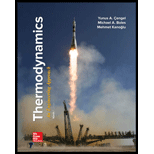
Concept explainers
Derive expressions for (a) Δu, (b) Δh, and (c) Δs for a gas whose equation of state is P(v − a) = RT for an isothermal process.
(a)
To drive an expression of
Answer to Problem 42P
The expression of
Explanation of Solution
Write the equation of state of the given gas.
Here, the temperature is
Write the general expression for change in internal energy
Here, the internal energy at state 1, 2 is
Rearrange the Equation (I) to obtain
Conclusion:
Partially differentiate the Equation (III) with respect to temperature by keeping the specific volume as constant.
Substitute
For an isothermal process, the temperature is kept constant.
The differential temperature or change in temperature becomes zero.
Substitute
Thus, the expression of
(b)
To drive an expression of
Answer to Problem 42P
The expression of
Explanation of Solution
Write the general expression for change in enthalpy
Here, the enthalpy at state 1, 2 is
Rearrange the Equation (V) to obtain
Conclusion:
Partially differentiate the Equation (VI) with respect to temperature by keeping the pressure as constant.
Substitute
For an isothermal process, the temperature is kept constant.
The differential temperature or change in temperature becomes zero.
Substitute
Thus, the expression of
(c)
To drive an expression of
Answer to Problem 42P
The expression of
Explanation of Solution
Write the general expression for change in entropy
Here, the entropy at state 1, 2 is
Conclusion:
Substitute
For an isothermal process, the temperature is kept constant.
The differential temperature or change in temperature becomes zero.
Substitute
Thus, the expression of
Want to see more full solutions like this?
Chapter 12 Solutions
Thermodynamics: An Engineering Approach ( 9th International Edition ) ISBN:9781260092684
- A mass of ideal gas in a closed piston-cylinder system expands from 427 °C and 16 bar following the process law, pv1.36 = Constant (p times v to the power of 1.36 equals to a constant). For the gas, initial : final pressure ratio is 4:1 and the initial gas volume is 0.14 m³. The specific heat of the gas at constant pressure, Cp = 0.987 kJ/kg-K and the specific gas constant, R = 0.267 kJ/kg.K. Determine the change in total internal energy in the gas during the expansion. Enter your numerical answer in the answer box below in KILO JOULES (not in Joules) but do not enter the units. (There is no expected number of decimal points or significant figures).arrow_forwardmy ID# 016948724. Please solve this problem step by steparrow_forwardMy ID# 016948724 please find the forces for Fx=0: fy=0: fz=0: please help me to solve this problem step by steparrow_forward
- My ID# 016948724 please solve the proble step by step find the forces fx=o: fy=0; fz=0; and find shear moment and the bending moment diagran please draw the diagram for the shear and bending momentarrow_forwardMy ID#016948724. Please help me to find the moment of inertia lx ly are a please show to solve step by stepsarrow_forwardplease solve this problem step by steparrow_forward
- Please do not use any AI tools to solve this question. I need a fully manual, step-by-step solution with clear explanations, as if it were done by a human tutor. No AI-generated responses, please.arrow_forwardPlease do not use any AI tools to solve this question. I need a fully manual, step-by-step solution with clear explanations, as if it were done by a human tutor. No AI-generated responses, please.arrow_forwardPlease do not use any AI tools to solve this question. I need a fully manual, step-by-step solution with clear explanations, as if it were done by a human tutor. No AI-generated responses, please.arrow_forward
 Principles of Heat Transfer (Activate Learning wi...Mechanical EngineeringISBN:9781305387102Author:Kreith, Frank; Manglik, Raj M.Publisher:Cengage Learning
Principles of Heat Transfer (Activate Learning wi...Mechanical EngineeringISBN:9781305387102Author:Kreith, Frank; Manglik, Raj M.Publisher:Cengage Learning Refrigeration and Air Conditioning Technology (Mi...Mechanical EngineeringISBN:9781305578296Author:John Tomczyk, Eugene Silberstein, Bill Whitman, Bill JohnsonPublisher:Cengage Learning
Refrigeration and Air Conditioning Technology (Mi...Mechanical EngineeringISBN:9781305578296Author:John Tomczyk, Eugene Silberstein, Bill Whitman, Bill JohnsonPublisher:Cengage Learning Automotive Technology: A Systems Approach (MindTa...Mechanical EngineeringISBN:9781133612315Author:Jack Erjavec, Rob ThompsonPublisher:Cengage Learning
Automotive Technology: A Systems Approach (MindTa...Mechanical EngineeringISBN:9781133612315Author:Jack Erjavec, Rob ThompsonPublisher:Cengage Learning


